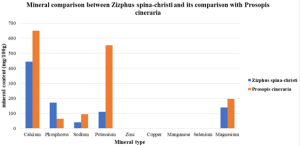
Evaluating Ziziphus Spina Christi (Sidr) and Prosopis Cineraria (Ghaf) as Essential Fodder Plants for Arabian Tahr
The Arabian Tahr, an agile mammal found in the rugged cliffs of the Al Hajar Mountains in the UAE and Oman, is facing numerous threats due to habitat destruction, climate change, and competition for food with domestic livestock. To ensure their survival, it is crucial to focus on habitat restoration and the availability of nutrient-rich fodder plants. The Fujairah Research Centre has conducted an in-depth study on the nutritional values of two native plants, Ziziphus Spina Christi (commonly known as Sidr) and Prosopis Cineraria (commonly known as Ghaf), which play a pivotal role in the diet of the Arabian Tahr. This study reveals that both Ziziphus Spina Christi and Prosopis Cineraria can thrive in the harsh conditions of the region, including high temperatures, saline soils, and low precipitation. These plants not only withstand these tough conditions but also provide vital nutrition to the Arabian Tahr. The nutritional values of Ziziphus Spina Christi and Prosopis Cineraria were examined using proximate analyses following international standard procedures set by the Association of Official Analytical Chemists (AOAC). Advanced techniques and instruments, including ICP-OES, HPLC, Gravimetry, and the Kjeldahl apparatus, were employed to obtain accurate mineral and nutritional analyses. The primary aim of the study was to compare the mineral content of these plants, focusing on essential minerals such as potassium, calcium, and magnesium, to determine which plant would be more beneficial in the Arabian Tahr’s diet. In this study, fresh leaf samples of Ziziphus Spina Christi and Prosopis Cineraria were collected from Al Taiba Farms in Fujairah, UAE.
Ziziphus Spina Christi is known for its resilience and is a significant source of nectar and pollen for bees, in addition to being consumed by cattle and other desert animals. The study found that Ziziphus Spina Christi provides substantial amounts of dry matter (75.92%) and contains higher phosphorus content compared to Prosopis Cineraria. However, its mineral content, particularly in calcium and potassium, was found to be lower than that of Prosopis Cineraria.On the other hand, Prosopis Cineraria, emerged as the superior plant in terms of nutritional value for the Arabian Tahr. This evergreen tree, which can grow up to 25 meters tall, contains higher concentrations of crucial minerals like calcium (650.21 mg/100g), potassium (552.32 mg/100g), and magnesium (196.14 mg/100g). These minerals are essential for the health and vitality of the Arabian Tahr, making Prosopis Cineraria a more beneficial component of their diet. The findings of this study have significant implications for conservation efforts aimed at protecting the Arabian Tahr. The superior nutritional profile of Prosopis Cineraria suggests that it should be prioritized in habitat restoration projects. By ensuring that these plants are readily available in the habitats of the Arabian Tahr, conservationists can support the health and sustainability of this endangered species. Furthermore, the research underscores the importance of preserving and propagating native plants like Ziziphus Spina Christi and Prosopis Cineraria, not only for the Arabian Tahr but also for the broader ecosystem. These plants contribute to the overall biodiversity of the region and play a crucial role in maintaining the ecological balance. While this study provides valuable insights into the nutritional benefits of these native plants, further research is needed to explore their full potential. Understanding how different environmental factors affect their growth and nutritional content could lead to more effective conservation strategies. In addition, exploring the potential of these plants in other regions with similar environmental conditions could help expand their use as fodder for other endangered species. This could contribute to global efforts in biodiversity conservation and sustainable agriculture. By focusing on native plant species that offer both resilience and high nutritional value, we can take significant steps toward preserving endangered species and their habitats for future generations.For more detailed information read the full article by Alsharari Aldhanhani, H. R., Mirza, S. B., & Ridouane, F. L. (2022). Investigation of the ziziphus spina christi (Sidr) and prosopis cineraria (Ghaf) as a priority fodder plant for arabian tahr by macro-mineral comparison analysis from the origin of Fujairah, UAE. In International Journal of Food Science and Nutrition (Vol. 7, Issue 4, pp. 92–95). https://www.foodsciencejournal.com
